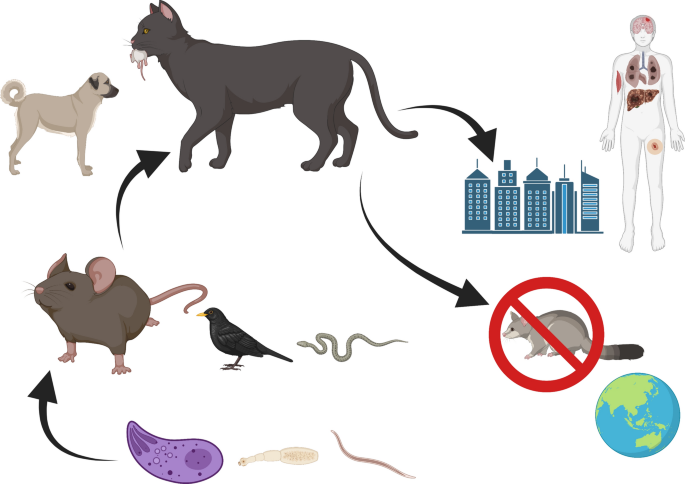Parasitology in Veterinary Medicine: Understanding Parasite Life Cycles and Control Measures
Abhishek Kumar, SK Maurya , Pramod Kumar, DP Srivastava, Hemant Singh, Vikas Rai, RK Verma
Introduction
Parasitology in veterinary medicine is important because it studies parasites that affect pets and cattle. Parasites dwell in or on hosts and steal nutrition. These microbes can cause minor discomfort to serious sickness and death. Understanding parasite life cycles and taking appropriate control methods are crucial to protecting animals and humans. Protozoa, helminths, and arthropods are parasites with distinct life cycles. Helminths are multicellular worms, protozoa are single-celled, and arthropods are insects and arachnids. Malaria, trypanosomiasis, gastrointestinal illnesses, and skin infections can result from these parasites’ effects on host organs.Parasite life cycles are essential to veterinary parasitology. Complex parasite life cycles encompass numerous phases and hosts. Eggs, larvae, nymphs, and adults are evolved to survive and reproduce in certain conditions. Some parasites grow or reproduce asexually in intermediate hosts before maturing and reproducing sexually in their final host.
Parasite Classification and Diversity
Veterinarian parasites include protozoa, helminths, and arthropods. Protozoa like coccidia and giardia are spread by contaminated food and water. Nematodes, cestodes, and trematodes—roundworms, tapeworms, and flukes—are helminths. These parasites usually infect the gastrointestinal tract or other organs, producing various animal symptoms. Arthropods like ticks, fleas, lice, and mites spread Lyme disease and mange. Each parasite group has distinct shape, life cycle, and pathology, requiring specialized diagnosis and management. Veterinarians must understand parasite categorization and variety to diagnose, treat, and prevent parasitic illnesses in animals.
Parasite Life Cycles
The life cycles of parasites are remarkably diverse and can include intricate interactions between environmental variables, intermediate hosts, and final hosts. These cycles usually include many stages, such as egg, larva, nymph, and adult forms. For each stage to reach its full growth, particular environmental factors or host species could be needed. For example, helminth parasites frequently have indirect life cycles, meaning that before they can be consumed by a suitable host, the eggs they shed in feces must mature into infectious larvae outside of the host. When transferred to a new host, protozoan parasites can reproduce sexually after first going through asexual reproduction inside their original host. At certain points in their life cycles, arthropod parasites like fleas and ticks need blood meals for growth and reproduction. In order to target susceptible stages and stop transmission channels with effective control methods, it is imperative to have a thorough understanding of these complex life cycles.
Clinical Manifestations of Parasitic Infections
Depending on the kind and intensity of the parasite involved, animal parasitic infections can present with a wide range of clinical symptoms. Gastrointestinal problems including diarrhea, vomiting, and weight loss are typical symptoms, and they may also be accompanied by discomfort and pain in the abdomen. Certain parasites, including fleas and ticks, can lead to dermatological problems such skin irritation, hair loss, and itching. Lung parasites can cause respiratory symptoms such as coughing and breathing difficulties. Furthermore, certain parasites can induce blood loss or nutritional depletion, which can lead to anemia, weakness, and lethargy. Serious parasite infections can result in organ damage, weakened immune systems, and even death. In veterinary medicine, timely identification and diagnosis of these clinical indicators are essential for the successful management and avoidance of parasite infections.
Diagnostic Techniques for Parasitic Infections
In veterinary medicine, diagnosing and treating parasite infections is greatly aided by diagnostic tools. Fecal examination, which involves the microscopic identification of parasite eggs, cysts, or oocysts, is still a fundamental technique. Furthermore, serological methods that identify antibodies specific to parasites, including ELISA and indirect fluorescent antibody tests, facilitate diagnosis. In order to identify parasite DNA in clinical samples with high sensitivity and specificity, polymerase chain reaction (PCR) techniques are used, which improves diagnostic accuracy. In addition to conventional fecal exams, other methods include fecal flotation, sedimentation, and direct smears. Every technique has benefits and drawbacks, thus a thorough approach to diagnosis is required. Reducing the burden of parasitic infections in veterinary practice is made possible by accurate diagnosis, which allows for tailored treatment and control methods. Therefore, a mix of diagnostic approaches ensures efficient management of parasite illnesses in animals.
Treatment and Control Measures
Veterinary parasitic infection treatment and management involves many methods to reduce parasite load and prevent transmission. Helminth infections are treated with anthelmintic medicines, which target parasite life cycles. Fleas, ticks, and mites are controlled with ectoparasiticides. Integrated parasite control uses pasture management, rotational grazing, and sanitation to prevent parasite exposure and environmental pollution. Effective parasite management requires regular deworming regimens adapted to animal types and areas. Strategic use of vaccinations, biosecurity, and quarantine protocols prevents parasitic illnesses from spreading in animal populations. Continuous surveillance and monitoring methods can identify new parasite risks and enable quick management. A comprehensive strategy combining pharmaceutical therapies and preventative measures is essential for veterinary parasitic infection therapy.
Conclusion
Veterinary parasitology protects animal health and wellbeing. Veterinarians can prevent, diagnose, and treat parasitic illnesses in pets, livestock, and wildlife by knowing parasite life cycles and controlling them. Veterinary practitioners can reduce animal populations’ parasitic illness burden by tailoring management measures to individual settings and species by understanding parasite biology, transmission mechanisms, and host relationships. Further research and advances in diagnostic and parasite control technologies improve our understanding and abilities to fight parasitic illnesses. Veterinary practitioners, researchers, and animal owners must work together to maintain animal health and the well-being of people and animals in shared ecosystems.


